Structure, Function and Regulation of a Second Pyruvate Kinase Isozyme in Pseudomonas aeruginosa
- PMID: 34867929
- PMCID: PMC8637920
- DOI: 10.3389/fmicb.2021.790742
Structure, Function and Regulation of a Second Pyruvate Kinase Isozyme in Pseudomonas aeruginosa
Abstract
Pseudomonas aeruginosa (PA) depends on the Entner-Doudoroff pathway (EDP) for glycolysis. The main enzymatic regulator in the lower half of the EDP is pyruvate kinase. PA contains genes that encode two isoforms of pyruvate kinase, denoted PykAPA and PykFPA. In other well-characterized organisms containing two pyruvate kinase isoforms (such as Escherichia coli) each isozyme is differentially regulated. The structure, function and regulation of PykAPA has been previously characterized in detail, so in this work, we set out to assess the biochemical and structural properties of the PykFPA isozyme. We show that pykF PA expression is induced in the presence of the diureide, allantoin. In spite of their relatively low amino acid sequence identity, PykAPA and PykFPA display broadly comparable kinetic parameters, and are allosterically regulated by a very similar set of metabolites. However, the x-ray crystal structure of PykFPA revealed significant differences compared with PykAPA. Notably, although the main allosteric regulator binding-site of PykFPA was empty, the "ring loop" covering the site adopted a partially closed conformation. Site-directed mutation of the proline residues flanking the ring loop yielded apparent "locked on" and "locked off" allosteric activation phenotypes, depending on the residue mutated. Analysis of PykFPA inter-protomer interactions supports a model in which the conformational transition(s) accompanying allosteric activation involve re-orientation of the A and B domains of the enzyme and subsequent closure of the active site.
Keywords: Entner-Doudoroff pathway; Pseudomonas aeruginosa; bacterial metabolism; glycolysis; pykF; pyruvate kinase; x-ray crystallography.
Copyright © 2021 Abdelhamid, Wang, Parkhill, Brear, Chee, Rahman and Welch.
Conflict of interest statement
The authors declare that the research was conducted in the absence of any commercial or financial relationships that could be construed as a potential conflict of interest.
Figures

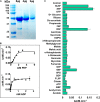
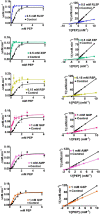
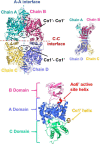
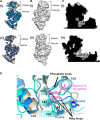
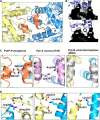

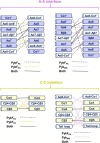
Similar articles
-
Evolutionary plasticity in the allosteric regulator-binding site of pyruvate kinase isoform PykA from Pseudomonas aeruginosa.J Biol Chem. 2019 Oct 18;294(42):15505-15516. doi: 10.1074/jbc.RA119.009156. Epub 2019 Sep 4. J Biol Chem. 2019. PMID: 31484721 Free PMC article.
-
Changes in the allosteric site of human liver pyruvate kinase upon activator binding include the breakage of an intersubunit cation-π bond.Acta Crystallogr F Struct Biol Commun. 2019 Jun 1;75(Pt 6):461-469. doi: 10.1107/S2053230X19007209. Epub 2019 Jun 10. Acta Crystallogr F Struct Biol Commun. 2019. PMID: 31204694 Free PMC article.
-
The allosteric regulation of pyruvate kinase by fructose-1,6-bisphosphate.Structure. 1998 Feb 15;6(2):195-210. doi: 10.1016/s0969-2126(98)00021-5. Structure. 1998. PMID: 9519410
-
The Entner-Doudoroff pathway: history, physiology and molecular biology.FEMS Microbiol Rev. 1992 Sep;9(1):1-27. doi: 10.1111/j.1574-6968.1992.tb05822.x. FEMS Microbiol Rev. 1992. PMID: 1389313 Review.
-
Pyruvate kinase: Function, regulation and role in cancer.Semin Cell Dev Biol. 2015 Jul;43:43-51. doi: 10.1016/j.semcdb.2015.08.004. Epub 2015 Aug 13. Semin Cell Dev Biol. 2015. PMID: 26277545 Free PMC article. Review.
Cited by
-
Pseudomonas aeruginosa acyl-CoA dehydrogenases and structure-guided inversion of their substrate specificity.Nat Commun. 2025 Mar 8;16(1):2334. doi: 10.1038/s41467-025-57532-z. Nat Commun. 2025. PMID: 40057486 Free PMC article.
-
Bacteria-Based Synergistic Therapy in the Backdrop of Synthetic Biology.Front Oncol. 2022 Apr 4;12:845346. doi: 10.3389/fonc.2022.845346. eCollection 2022. Front Oncol. 2022. PMID: 35444948 Free PMC article. Review.
-
Pyruvate kinase 2 from Synechocystis sp. PCC 6803 increased substrate affinity via glucose-6-phosphate and ribose-5-phosphate for phosphoenolpyruvate consumption.Plant Mol Biol. 2024 May 17;114(3):60. doi: 10.1007/s11103-023-01401-0. Plant Mol Biol. 2024. PMID: 38758412 Free PMC article.
-
All DACs in a Row: Domain Architectures of Bacterial and Archaeal Diadenylate Cyclases.J Bacteriol. 2023 Apr 25;205(4):e0002323. doi: 10.1128/jb.00023-23. Epub 2023 Apr 6. J Bacteriol. 2023. PMID: 37022175 Free PMC article. Review.
References
-
- Al-Zaid Siddiquee K., Arauzo-Bravo M. J., Shimizu K. (2004). Metabolic flux analysis of pykF gene knockout Escherichia coli based on 13C-labeling experiments together with measurements of enzyme activities and intracellular metabolite concentrations. Appl. Microbiol. Biotechnol. 63 407–417. 10.1007/s00253-003-1357-9 - DOI - PubMed
LinkOut - more resources
Full Text Sources

